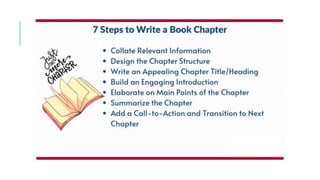Book Chapter Writing.pptx
- 1. HOW TO WRITE AN ACADEMIC BOOK CHAPTER? Ahsan Zaman
- 2. ACADEMIC BOOK CHAPTER 1. Focused on a research theme 2. An expert compilation that provides a perspective on research (usually scattered in journals and other publications) 3. More broadly focused than a journal article 4. Greater educational value! Often appear in the reading lists of undergraduate and postgraduate students
- 3. BRAINSTORMING BEFORE HEAD- START! The questions that may arise when you plan on writing a book chapter are: 1. Where do I start from? 2. How do I even do this? 3. What should be the length of book chapter? 4. How should I link one chapter to the following chapter?
- 4. HOW LONG SHOULD A BOOK CHAPTER BE? Between 3500 and 7000 words
- 5. DIFFERENCE BETWEEN A BOOK CHAPTER AND THESIS CHAPTER
- 7. HOW TO WRITE A BOOK CHAPTER? Step 1: Collate Relevant Information âĒ To review and collate all the relevant data âĒ Must focus on one concrete idea (it should not include any gaps that perplexes the reader) âĒ Creating mind-maps to link different sources and compile them âĒ Sort the ideas into a logical order of how you should present them in your chapter
- 8. HOW TO WRITE A BOOK CHAPTER? Step 2: Design the Chapter Structure âĒ Create a structured outline
- 9. A WELL STRUCTURED CHAPTER A well-structured chapter includes the following elements: 1. A title or heading 2. An interesting introduction 3. Main body informative paragraphs 4. A summary of the chapter 5. Smooth transition to the next chapter
- 10. HOW TO WRITE A BOOK CHAPTER? Step 3: Write an Appealing Chapter Title/Heading âĒ An impactful chapter title captures the readerâs attention. Itâs basically the âfirst sightâ rule!
- 11. HOW TO WRITE A BOOK CHAPTER? Step 4: Build an Engaging Introduction âĒ Write an introduction that keeps them hooked on âĒ Use a narrative approach or build a fictional plot to grab the attention of the reader âĒ Ensure that you do not deviate from the main context of your chapter âĒ Writing an effective introduction will help you in presenting an overview of your chapter
- 12. HOW TO WRITE A BOOK CHAPTER? Step 4: Build an Engaging Introduction Some of the tricks to follow when writing an exceptional introduction are: âĒ Share an anecdote âĒ Create a dialogue or conversation âĒ Include quotations âĒ Create a fictional plot
- 13. HOW TO WRITE A BOOK CHAPTER? Step 5: Elaborate on Main Body of the Chapter âĒ Expand your opening statement and begin to explain your points in detail âĒ Leave no space for speculation in the readerâs mind This section should answer the following questions of the reader: âĒ Why has the reader chosen to read your book? âĒ What do they need to know? âĒ Are their questions and doubts being resolved with the content of your chapter?
- 14. HOW TO WRITE A BOOK CHAPTER? Step 5: Elaborate on Main Body of the Chapter You could formulate these points into 4-5 paragraphs based on the details of your chapter. âĒ Build each point coherently (follow a cohesive flow) âĒ Provide statistical data âĒ Evidence-based information âĒ Experimental data âĒ Graphical presentations, etc.
- 15. HOW TO WRITE A BOOK CHAPTER? Step 5: Elaborate on Main Body of the Chapter âĒ Write in a clear language âĒ Avoiding jargon âĒ Explain concepts clearly so your work is easy to understand âĒ Get support and feedback from senior academics (any gaps or references you should include?)
- 16. HOW TO WRITE A BOOK CHAPTER? Step 6: Summarize the Chapter âĒ This section is a key takeaway for your readers! âĒ Revisit your chapterâs main content and summarize it âSince your chapter has given a lot of information, youâd want the reader to remember the gist of it as they reach the end of your chapter. Hence, writing a concise summary that constitutes the crux of your chapter is imperative.â
- 17. HOW TO WRITE A BOOK CHAPTER? Step 7: Add a Call-to-Action & Transition to Next Chapter This section comes at the extreme end of the book chapter âĒ You ask the reader to implement the learnings from the chapter âĒ It is a way of applying their newly acquired knowledge âĒ Can also add a transition from your chapter to the succeeding chapter
- 18. ADVANTAGES OF PUBLISHING AN ACADEMIC BOOK CHAPTER Publishing a book chapter can help you to be considered as a credible author and expert in your field. âĒ Academics often read chapter books to keep up to date and for teaching purposes, which means your work might be cited in essays and dissertations. âĒ A chapter in a good, edited collection indicates to an employment panel or a publisher that your work has been sought by senior academics and that you have the potential to author a book. âĒ You can use a book chapter to expand on a topic you introduced in a journal article, although you will need permission from the journalâs editor to quote passages of the article if it is behind a paywall. âĒ You donât need to convince readers that your contribution is important. The editors will take care of this in the foreword of the book. This will allow you to be more confident and creative in your writing.


















